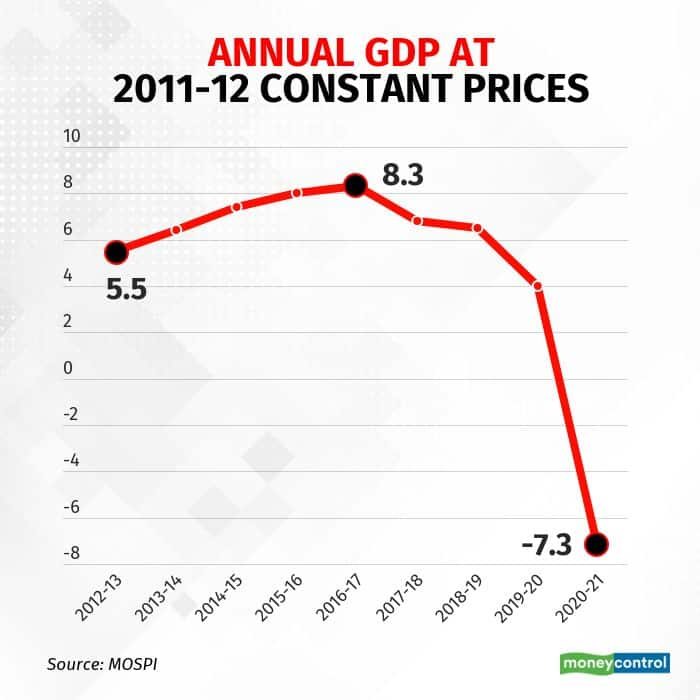According to the government recently released data, India’s gross domestic product (GDP) grew at 1.6 per cent in the January-March quarter of fiscal year 2020-21. But additionally it witnessed a contraction of 7.3 per cent for the entire fiscal year 2020-21.
It is to be noted that India recorded its worst ever performance in over four decades as India clocked a negative growth of 7.3 per cent for 2020-21. Meanwhile the fourth quarter of the fiscal year 2020-21 showed a meagre rise of 1.6 per cent. The GDP numbers released by the National Statistical Office (NSO), reflect the delicate and nascent stage of the nation’s economy. Since all sectors had been completely opened and the situation was near normal, a 1.6 per cent growth during the fourth quarter of FY21 shows the ill health of the economy.
In a press release, Ministry of Statistics & Programme Implementation stated that “Real GDP or Gross Domestic Product (GDP) at Constant (2011-12) Prices in the year 2020-21 is now estimated to attain a level of ₹ 135.13 lakh crore, as against the First Revised Estimate of GDP for the year 2019-20 of ₹ 145.69 lakh crore, released on 29th January 2021. The growth in GDP during 2020-21 is estimated at -7.3 percent as compared to 4.0 percent in 2019-20,”.
Even before the pandemic had struck, India’s economy wasn’t performing well as in 2019-20, the GDP had shown a poor growth of four per cent. This was an 11-year low, mainly due to contraction in secondary sectors like manufacturing and construction.
It is to be noted that the GDP in the first quarter of 2020-21 had shrunk by 24.38 per cent, hit mainly by the Covid-19 pandemic. The economy snapped out of technical recession in the October-December quarter of the financial year 2020-21 and expanded by a revised 0.5 per cent, after reporting two consecutive quarters of de-growth in the same fiscal
Thus, the fiscal year 2020-21 was the first full-year of contraction in the Indian economy in the last four decades since 1979-80, when GDP had shrunk by 5.2 per cent. The growth of 1.6% in the fourth quarter makes it the second straight quarter of expansion since India exited a rare recession.
Sectoral performance
According to the data released by the National Statistical Office, gross value added (GVA) growth in the manufacturing sector accelerated to 6.9 per cent in the fourth quarter of 2020-21, compared to a contraction of 4.2 per cent a year ago. On the other hand, farm sector GVA growth was down at 3.1 per cent, compared to 6.8 per cent in the corresponding period of 2019-20. Additionally, the construction sector GVA grew by 14.5 per cent from 0.7 per cent growth earlier. Mining sector shrank by 5.7 per cent, as against a contraction of 0.9 per cent a year ago.
As trade, hotel, transport, communication and services were the worst hit during the pandemic, they contracted by 2.3 per cent in the fourth quarter from 5.7 per cent growth earlier.
It is to be noted that public administration, defense and other services growth too fell to 2.3 per cent during the quarter under review. It fell from 9.6 per cent to 2.3 per cent from a year earlier.
Ministry of Statistics & Programme Implementation stated that “GDP at constant (2011-12) prices in Q4 of 2020-21 is estimated at Rs 38.96 trillion as against Rs 38.33 trillion in Q4 of 2019-20, showing a growth of 1.6 per cent.”

picture credits- money control
The statement additionally maintained that the measures taken by the government to contain the spread of the pandemic have had an adverse impact on economic activities as well as data collection mechanisms as it curtailed field visit due to stringent lockdowns.
NSO stated that “The measures taken by the government to contain spread of the Covid-19 pandemic have had an impact on economic activities as well as on data collection mechanisms,”.
However, the sectoral performance (aforementioned) in Q4FY21 reveals that there was definitely a recovery in manufacturing, construction and finance, real estate etc. sectors. Thus, this could which have boded well for FY22 if the second wave had been timely mitigated. On the contrary, it led to a closedown of services sector in particular, thus progress might remain muted.
However it is to be noted that the NSO had estimated a GDP contraction of 7.7 per cent in 2020-21, in its first advance estimates of national accounts released in January this year. It was a revision from the earlier projections of 8% contraction.
In MPC’s first bi-monthly monetary policy review for the new financial year 2021-22, the Reserve Bank of India (RBI), retained its GDP growth projection at 10.5 per cent in the current fiscal 2021-22.
It stated that “Looking forward, while the y/y numbers for the first quarter might look upbeat due to a low base, the sequential growth is likely to contract. In particular, with the spread of the virus more acute in rural areas in this wave, rural demand and sectors dependent on the rural economy might come under stress.”
Sakshi Gupta, senior economist, HDFC Bank, Gurugram told Reuters that “With a more muted rural support this year, along with ongoing supply disruptions, we expect GDP growth at 8-10% for FY22, revised down from our earlier estimate of 11.5%,”.
“The Q4FY21 GDP growth of 1.6% reflects the full impact of unlocking of the economy post COVID-19 shock (of first wave). While the second wave of infections has been much more severe, the absence of a stringent nationwide lockdown has been a positive.”
Garima Kapoor, economist- institutional equities, Elara Capital, Mumbai stated that “The impact during the second wave has been more pronounced on consumer sentiment and mobility rather than economic activity. The rebound in consumer spending would hence be more gradual than the first wave with vaccination being the key driver. We expect FY22 GDP growth at 10.5% vs our earlier estimate of 12.5%,”.

